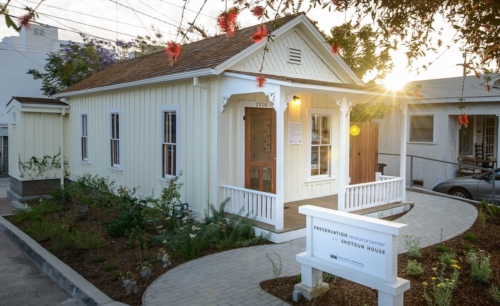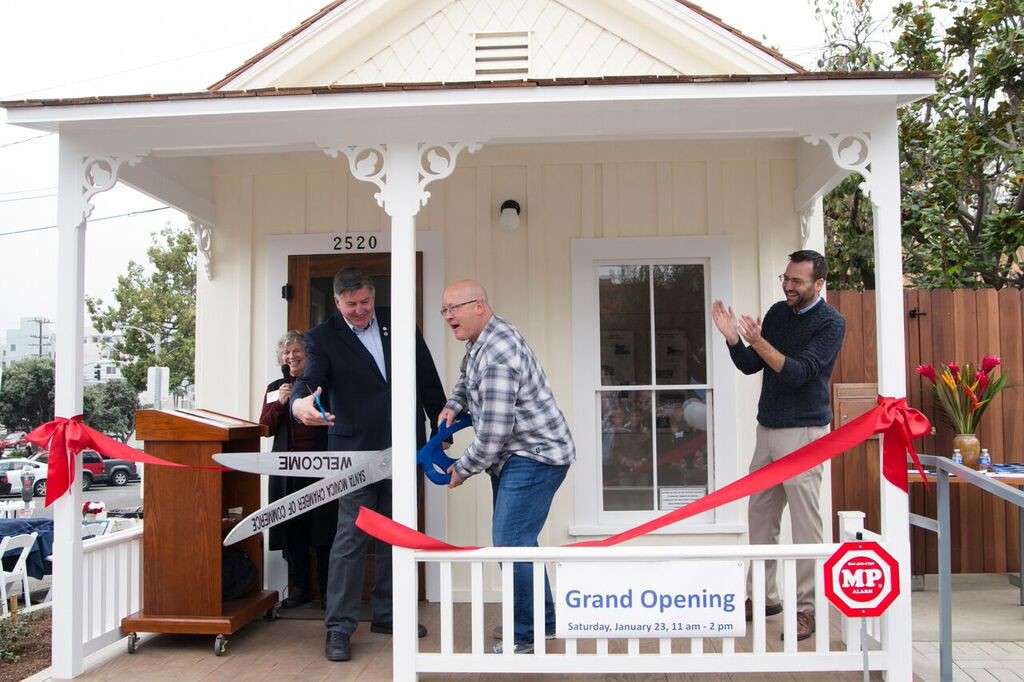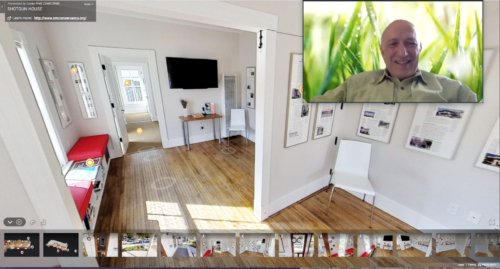Shotgun House
The Shotgun House at 2520 Second Street is many things—an authentic piece of Ocean Park’s history, a LEED Gold example of adaptive reuse, and the hub of the Conservancy’s newest events and programs, designed to deliver a shared experience of place and to activate our little house as a local cultural commons.
The Shotgun House will be open for free, in-person tours on the second Saturday and Sunday of the month.
The Conservancy is excited to present two new tour experiences, leaving from the Shotgun House the second Saturday and Sunday of each month!
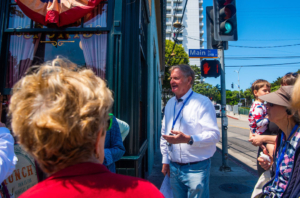
Far more than a history lesson, the MAIN STREET WALK focuses on the vibrant hub of our local Ocean Park neighborhood, upon which its histories are written. Upcoming walks leave from the Shotgun House the second Saturday of the month at 10:30. The event is free but please RSVP by clicking HERE.
AND
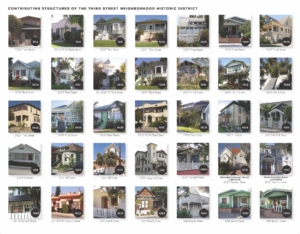
The Conservancy’s THIRD STREET WALK reveals the architectural and historical highlights and evolution of Santa Monica’s very first historic district, established in 1990. The neighborhood contains 27 original bungalows built between 1903 and 1915, as well as four structures from the late 1800s. Upcoming walks leave from the Shotgun House the second Sunday of the month at noon. This event is also free, and also requires and RSVP HERE.
More About the Shotgun House
Built in 1897, the little house features three original rooms where you can explore Santa Monica history and learn about heritage conservation. Look behind the walls and the floor to reveal vintage materials, and see if you can find the one original window in the Shotgun House. Young guests will also enjoy the miniature model house decorated with Victorian-era furnishings that were popular when our shotgun house was first built!
Our friendly and knowledgeable docents will share information about what life was like in the early 1900s, how the house was saved and rehabilitated, and answer any questions you may have.
Walk-ups are welcome and reservations are not required.
Self-Guided Virtual Tour
Tips for Navigating
- Click the “360” icons to rotate your exterior view of the house.
- Click the “Walking Person” icon to enter the house.
- Press the “Play” button in the bottom left to start a guided tour.
- Click on the orange dots to access more information about a feature.
The 3D scan of the house was created by Lucas Preti of Coral Climb Productions, a boutique company based in Santa Monica with expertise in documentaries, virtual reality and augmented reality.
What is a Preservation Resource Center?
Our award-winning Shotgun House is the last intact shotgun house in Santa Monica. It serves as a model for adaptive reuse and showcases an important piece of Santa Monica’s history. This little house has achieved remarkable things! Since opening in 2016, it has welcomed and educated thousands of visitors, earned LEED Gold certification for its green building strategies, and has received several awards:
- California Preservation Foundation Preservation Design Award
- Governor’s Historic Preservation Award
- Los Angeles Business Council Preservation Award
- Los Angeles Conservancy Preservation Award
- U.S. Green Building Council- Los Angeles Chapter
Among the Center’s sustainable features is the Shotgun House Coastal Garden, which is completely organic, filled with drought-resistant native plants, and cleanses storm water and dry weather runoff.
History of the Shotgun House
The Shotgun House was built in 1897 at 2712 Second Street in Ocean Park. In the 1890s Ocean Park was being subdivided and settled and was growing fast as a resort area. In Ocean Park’s first phase of development, shotgun houses were built or brought in by rail to serve as vacation cottages near the beach. This house was originally located just two blocks from the Santa Fe railroad depot in Ocean Park and within easy reach of the area’s tourist attractions. As such it is linked with one of Santa Monica’s oldest and most important industries: tourism.
Architectural historians believe this type of house was first seen in the Caribbean (resulting from a blend of African and European influences). By the early nineteenth century this modest type of structure had become ubiquitous in the rural South and was particularly common as dwellings for African-Americans.
Inexpensive to build, easy to transport and adaptable to diverse purposes, the shotgun style spread across the country during the nineteenth century. Shotgun houses found use during the Civil War as field housing, sprung up in mining towns across the West, sheltered railroad workers laying tracks across the nation, and offered economical shelter for people of limited means in many communities. In Santa Monica and other resort areas, shotgun homes were also useful as vacation cottages.
Our Shotgun House is a good example of the form with three small rooms lined up in a row. (See shotgun houses across the U.S.) Like most shotgun houses, this board-and-batten structure features a covered front porch and a gabled roof. Ornamentation is minimal but the diamond-shaped shingles on the front gable provide a hint of Queen Anne styling. (Originally the house also included some Victorian scrolled brackets on the porch posts.) Though presently enclosed, several sash windows on both sides of the house once provided light and ventilation.
The shotgun house is remarkable for its sheer tenacity. Because many shotgun houses were flimsily built, many did not stand up well to the passage of time. By the mid-twentieth century a number of Santa Monica’s shotgun houses had been deemed unsafe and bulldozed. Many other shotgun houses that were not decrepit were destroyed due to development pressure over the last century. Yet, against all odds, our Shotgun House persisted, and was occupied as a residence until 1996. Facing destruction in 2002, it was moved from its original site and became the focus of efforts by community members and the City of Santa Monica to restore and relocate it.
Over the next sixteen years, the house became the property of the City, and was relocated two more times before a permanent location was found in the parking lot across from Norman Place and the Ocean Park Library in 2014.
Under the guardianship of the Santa Monica Conservancy, an adaptive reuse plan was developed, a lease was negotiated, and funds were raised to sensitively rehabilitate and transform the little shotgun house into a Preservation Resource Center. In January 2016, the Resource Center celebrated its grand opening. (Read about the grand opening in the LA Times.)
Live Virtual Tour
Postponed for now.
Can’t make the in-person tour? Take a virtual step inside our shotgun house with docent and architect Mario Fonda-Bonardi! Learn about life, history and architecture in Santa Monica in the early 1900s on this free virtual tour. Discover the journey of this incredible little house, which was saved from demolition and moved on wheels three times before being adapted into our modern-day Center.
Register online today! During the 45 minute tour, you’ll get a chance to take a walk through history, hear stories about early Santa Monica and ask questions. The tour is free and will be held via Zoom.
